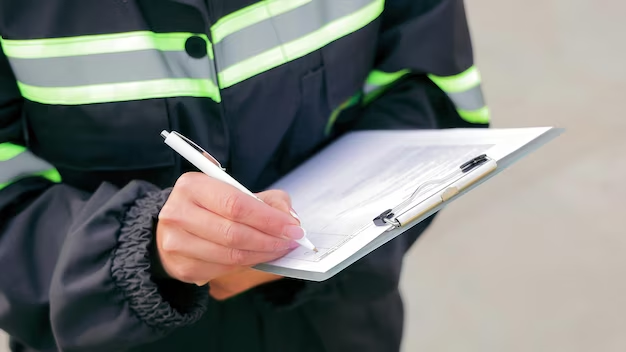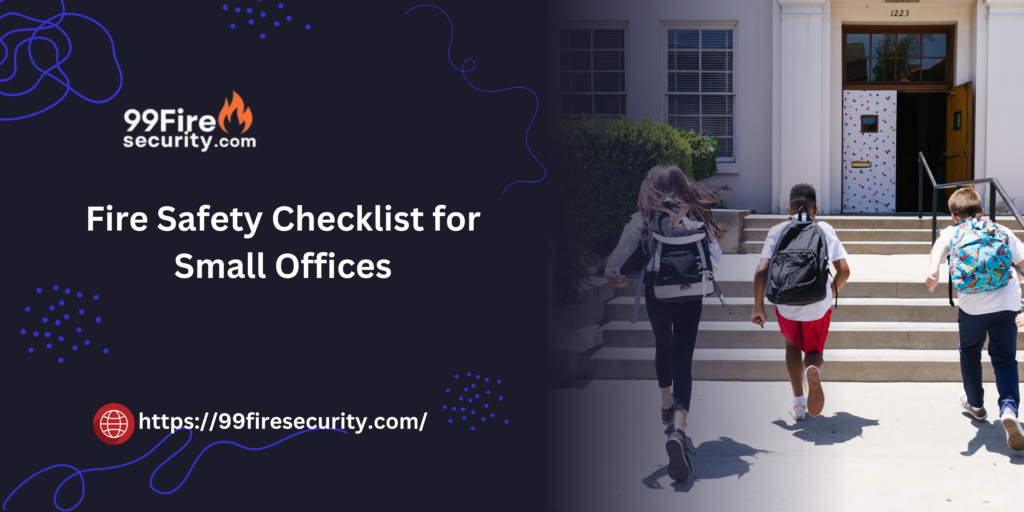For an owner of a small office, employee and visitor safety come first. House fires don’t happen with a warning, and it can cost you your life. The checklist is known to keep you prepared and minimize hazards related to fire in the workplace. This all-inclusive checklist highlights all the necessary fire safety measures that small office owners can take to make their workplace safer.
Fire Safety Checklist
1. Install Smoke Detectors and Fire Alarms
Want: If your home is new, wish; if old, install smoke detectors and fire alarms on every floor and in the kitchen (if you have one).
Do this: Test alarms monthly so you know they are working.
Make a plan: Change the batteries at least once a year.
2. Conduct Regular Fire Drills
Action: Have fire drills at least two times a year.
Make sure all staff members know where emergency exits are, where to go in the event of an evacuation, and where fire safety equipment is located.
Step 2—Identify a Meeting Point Outside the Office: Pick an area outside of the office where employees can meet after they have evacuated.

3. Maintain Fire Extinguishers
Action: Make sure fire extinguishers are located in visible and convenient places, especially in areas at high risk for fire (kitchens, electrical rooms).
Action: Monthly inspection to ensure fire extinguishers are correctly pressurized, not damaged, and usable.
The Fix: Take them in for professional servicing and recharging once a year.
4. Examine Electrical Cables and Devices
Action: Schedule licensed electrical inspections of the office at least once a year.
Action: Make sure that electrical wiring is not frayed or damaged, and replace faulty wiring right away.
Action: Do not overload electrical outlets and power strips or risk sparking or electrical fire.
5. Keep Fire Exits Unobstructed
Be aware: All fire exits should always be properly signed and not blocked.
Act: Keep exits, stairwells and hallways clear of debris or obstructions that might interfere with a rapid evacuation.
Take action: Check that the exit signs are lit and visible in dark areas.

6. Store Flammable Materials Safely
Action: Keep chemicals, cleaning supplies, and other flammable materials in proper, labelled container
Do: Store and use these materials away from sources of heat, including
electrical equipment, stoves, or space heaters.
Action: Wrap and dispose of paper waste and other combustible materials regularly in a fire-safe manner.
7. Install Sprinkler Systems (If Applicable)
Solution: Install an automatic sprinkler system in the office, particularly if it’s a big office space.
Action: Inspect and maintain sprinklers routinely to eliminate any obstructions and ensure they are in good working condition.
Action: Perform sprinkler system testing per 3rd party guidelines.
8. Maintain Heating Equipment and Space Heaters
Action: Use space heaters on flat, stable surfaces away from combustible materials.
Precaution: Don’t leave space heaters unattended, especially overnight.
Action: Get central heating systems or VAC units professionally inspected and serviced at least annually.
9. Post Fire Safety Signage
Action: Hang signs in the office with fire escape routes, evacuation procedures, and where fire extinguishers are located.
Action: Educate all employees on where these signs are located and the procedure to take in an emergency.
10. Train Employees on Fire Safety
Action: Give fire safety training for all employees, including the following:
Evacuation procedures
How to use a fire extinguisher (P.A.S.S.: Pull, Aim, Squeeze, Sweep)
How to recognize fire hazards
Emergency contact information
Tip: Assign fire marshals to help with evacuation should something happen.
Action: Conduct regular refresher courses or fire safety updates to help all employees stay aware.
11. Install Fire Doors
Action Packaged: Ensure fire doors are fitted in at-risk locations and that they are free from obstruction.
Action: Keep fire doors closed and never wedged open.
Procedure: Inspect fire doors regularly for any signs of wear and tear.
12. Keep Emergency Contacts Accessible
Action: Make sure that all emergency numbers (fire department, medical services, etc.) are posted near every telephone and in common areas.
Action: Ensure that employees have an emergency contact list—both at the company (Human Resources, security, etc.) and outside, at local emergency services.
13. Create a Fire Safety Plan
Recommendation: Your fire safety plan should be extensive, as it must include evacuation routes, fire extinguisher locations, and responsibilities during an emergency.
Training: Provide fire safety training to all employees annually and whenever there are changes to the office layout or emergency procedures.
Action: Distribute the plan to all employees, making clear who has what role in an emergency.
Conclusion
Fires can start END when least expected, especially in offices, but with adequate preparation, the chances of fire disasters can be minimized. Following this fire safety checklist gives you thorough fire safety equipment for your office and offers a secured working environment to your employees. Proper maintenance, training, and following safety measures can prevent fires and reduce damage in a fire.
FAQs
1. How often should fire drills be conducted in a small office?
Fire drills should be at least twice a year to familiarize employees with evacuation procedures that will help everyone act quickly in case of an emergency.
2. Can I store cleaning supplies near electrical equipment?
No; cleaning supplies and other flammable materials should be stored away from your electrical equipment, heat sources, or other items that can create a spark or a fire.
3. Are there any fire safety requirements for small offices with less than 10 employees?
Even small offices need to abide by their local fire safety regulations. These can differ, but, generally, the same regulations apply to companies of any size, including installing smoke detectors, performing fire drills, and making sure the office has fire extinguishers.
4. How often should fire extinguishers be inspected?
Fire extinguishers should be checked monthly for damage and pressure. They also need to be professionally inspected and recharged annually.
5. What are the key elements of a fire safety plan?
Fire safety plan: A fire safety plan must be drawn up beforehand and should include evacuation routes, fire extinguisher locations, roles and responsibilities in case of emergency, meeting points outside the office, etc.
Use this checklist so that small office owners can help secure the safety of their employees and guests while following fire safety protocols. Implementing fire safety measures is a perennial responsibility that can help avoid catastrophic situations in the workplace.


